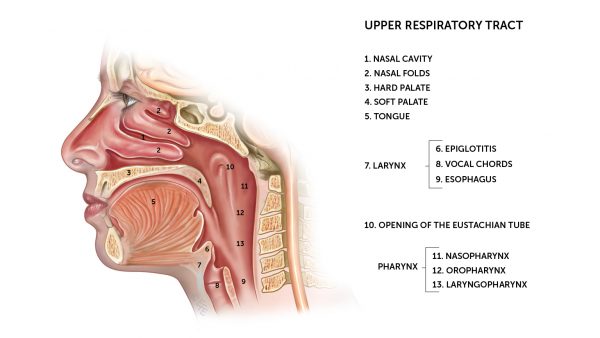The nasal cavity is divided into two by a dividing wall called the nasal septum. Each of the nostrils lead to each half of the nasal cavity. The air from each half meet and mix completely behind the soft palate.
In each half of the nasal cavity, we have three folds (choncae nasalis Fig. 2). These folds give the nasal cavity a large surface. The air that is breathed in enters the nasal cavity and distributes above and below the three folds. The air is filtered, humidified and heated. Inside the nasal cavity, we find mucus that moistens and captures dust and other particles. In addition, there are cells with cilia that brush away particles. Cilia located anteriorly in the nasal cavity, brush toward the nostrils, while the cilia posterior to the nasal cavity brush particles back so that it ends up in the throat and finally into the stomach, where any bacteria are killed by the acidic gastric juice. The cells that make the mucus also secrete various substances including lysozymes and defensins which have antibacterial effects. In addition, the nasal cavity also functions as a resonant chamber and odour organ. The sensory cells for smell are located in the roof of the nasal cavity.
From the nasal cavity, the air is led into the throat (pharynx). The pharynx is divided anatomically into three regions (Fig. 2):
- nasopharynx (the upper part)
- oropharynx (the middle part)
- laryngopharynx (the lower part)
In the nasopharynx, are the tonsils and the opening of the Eustachian tube. The wall of the nasopharynx has skeletal muscle which initiates swallowing – a voluntary mechanism.
In the oropharynx, air and food are mixed. Here too we find tonsils. At the bottom, in the laryngopharynx, there is smooth muscle that control the swallowing process in an involuntary contraction after it is initiated in the nasopharynx.
Below the laryngopharynx is the larynx (Fig. 2) containing the vocal cords. The larynx is the air passage that takes air into the trachea (windpipe). In the laryngopharyngeal region air is led into the trachea, and the food is directed down the oesophagus So when you breathe, you will not normally swallow, and when you swallow, you do not breathe. The epiglottis (laryngeal cartilage cap) has an active role in this process. The epiglottis controls switching between air and food supplies by bending to cover over the trachea during swallowing and thus preventing food entering the trachea.




